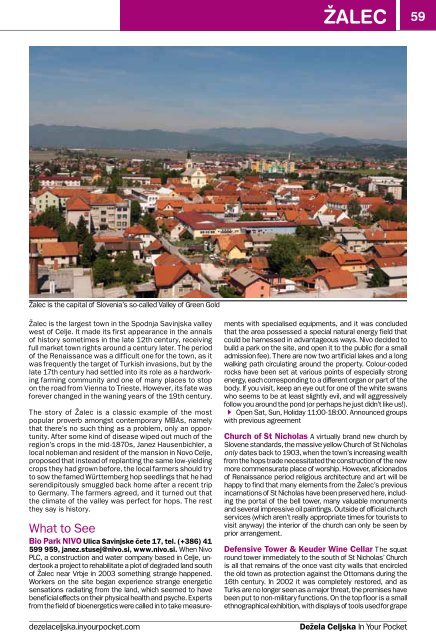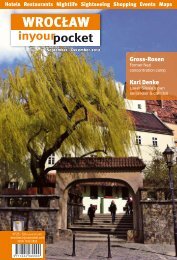You also want an ePaper? Increase the reach of your titles
YUMPU automatically turns print PDFs into web optimized ePapers that Google loves.
Žalec is the capital of Slovenia’s so-called Valley of Green Gold<br />
Žalec is the largest town in the Spodnja Savinjska valley<br />
west of Celje. It made its first appearance in the annals<br />
of history sometimes in the late 12th century, receiving<br />
full market town rights around a century later. The period<br />
of the Renaissance was a difficult one for the town, as it<br />
was frequently the target of Turkish invasions, but by the<br />
late 17th century had settled into its role as a hardworking<br />
farming community and one of many places to stop<br />
on the road from Vienna to Trieste. However, its fate was<br />
forever changed in the waning years of the 19th century.<br />
The story of Žalec is a classic example of the most<br />
popular proverb amongst contemporary MBAs, namely<br />
that there’s no such thing as a problem, only an opportunity.<br />
After some kind of disease wiped out much of the<br />
region’s crops in the mid-1870s, Janez Hausenbichler, a<br />
local nobleman and resident of the mansion in Novo Celje,<br />
proposed that instead of replanting the same low-yielding<br />
crops they had grown before, the local farmers should try<br />
to sow the famed Württemberg hop seedlings that he had<br />
serendipitously smuggled back home after a recent trip<br />
to Germany. The farmers agreed, and it turned out that<br />
the climate of the valley was perfect for hops. The rest<br />
they say is history.<br />
What to See<br />
Bio Park nIVO Ulica Savinjske čete 17, tel. (+386) 41<br />
599 959, janez.stusej@nivo.si, www.nivo.si. When Nivo<br />
PLC, a construction and water company based in Celje, undertook<br />
a project to rehabilitate a plot of degraded land south<br />
of Žalec near Vrbje in 2003 something strange happened.<br />
Workers on the site began experience strange energetic<br />
sensations radiating from the land, which seemed to have<br />
beneficial effects on their physical health and psyche. Experts<br />
from the field of bioenergetics were called in to take measure-<br />
dezelaceljska.inyourpocket.com<br />
Žalec 59<br />
ments with specialised equipments, and it was concluded<br />
that the area possessed a special natural energy field that<br />
could be harnessed in advantageous ways. Nivo decided to<br />
build a park on the site, and open it to the public (for a small<br />
admission fee). There are now two artificial lakes and a long<br />
walking path circulating around the property. Colour-coded<br />
rocks have been set at various points of especially strong<br />
energy, each corresponding to a different organ or part of the<br />
body. If you visit, keep an eye out for one of the white swans<br />
who seems to be at least slightly evil, and will aggressively<br />
follow you around the pond (or perhaps he just didn’t like us!).<br />
Q Open Sat, Sun, Holiday 11:00-18:00. Announced groups<br />
with previous agreement<br />
Church of St nicholas A virtually brand new church by<br />
Slovene standards, the massive yellow Church of St Nicholas<br />
only dates back to 1903, when the town’s increasing wealth<br />
from the hops trade necessitated the construction of the new<br />
more commensurate place of worship. However, aficionados<br />
of Renaissance period religious architecture and art will be<br />
happy to find that many elements from the Žalec’s previous<br />
incarnations of St Nicholas have been preserved here, including<br />
the portal of the bell tower, many valuable monuments<br />
and several impressive oil paintings. Outside of official church<br />
services (which aren’t really appropriate times for tourists to<br />
visit anyway) the interior of the church can only be seen by<br />
prior arrangement.<br />
Defensive Tower & Keuder Wine Cellar The squat<br />
round tower immediately to the south of St Nicholas’ Church<br />
is all that remains of the once vast city walls that encircled<br />
the old town as protection against the Ottomans during the<br />
16th century. <strong>In</strong> 2002 it was completely restored, and as<br />
Turks are no longer seen as a major threat, the premises have<br />
been put to non-military functions. On the top floor is a small<br />
ethnographical exhibition, with displays of tools used for grape<br />
Dežela Celjska <strong>In</strong> <strong>Your</strong> <strong>Pocket</strong>

















